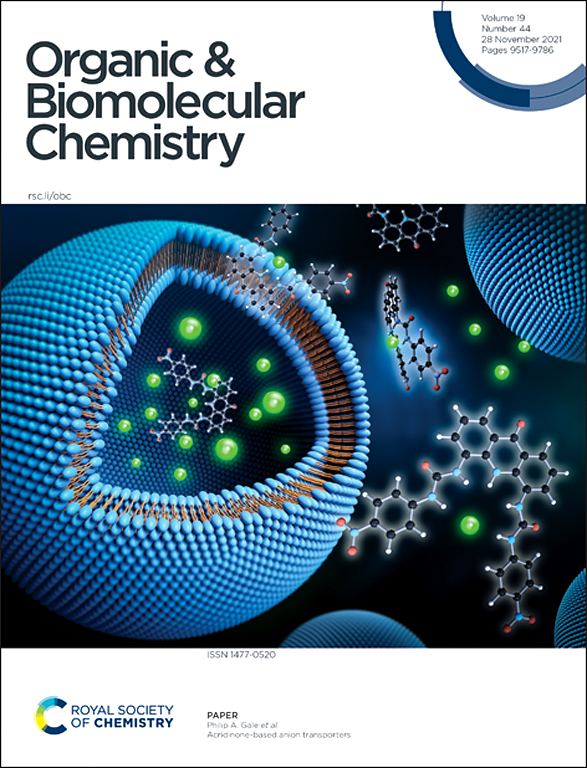区域选择性双脱水环化途径构建由2,3-二氢喹唑啉-4(1H)- 1和1,2-二氢吡咯[1,2-a]吡嗪组成的多杂环骨架。
IF 2.7
3区 化学
Q1 CHEMISTRY, ORGANIC
引用次数: 0
摘要
Sc(OTf)3催化2-氨基苯甲酰胺与n-取代吡咯-2-甲醛的反应进行得很好,通过区域选择性双环脱水得到由二氢喹啉-4- 1和1,2-二氢吡咯[1,2-a]吡嗪组成的四环骨架,其中两个杂环(喹唑啉酮和吡嗪)通过形成三个C-N键依次构建。本文章由计算机程序翻译,如有差异,请以英文原文为准。
![Regioselective double dehydrative cyclization route to construct polyheterocyclic skeletons consisting of 2,3-dihydroquinazolin-4(1H)-ones and 1,2-dihydropyrrolo[1,2-a]pyrazines†](https://img.booksci.cn/booksciimg/2025-6/102305311791782879246.jpg)
Regioselective double dehydrative cyclization route to construct polyheterocyclic skeletons consisting of 2,3-dihydroquinazolin-4(1H)-ones and 1,2-dihydropyrrolo[1,2-a]pyrazines†
The Sc(OTf)3-catalyzed reaction of 2-aminobenzamide with N-substituted pyrrole-2-carboxaldehyde proceeded well to give a tetracyclic skeleton consisting of dihydroquinazolin-4-one and 1,2-dihydropyrrolo[1,2-a]pyrazine via regioselective double cyclodehydrations where two heterocyclic rings (quinazolinone and pyrazine) were sequentially constructed through the formation of three C–N bonds.
求助全文
通过发布文献求助,成功后即可免费获取论文全文。
去求助
来源期刊

Organic & Biomolecular Chemistry
化学-有机化学
CiteScore
5.50
自引率
9.40%
发文量
1056
审稿时长
1.3 months
期刊介绍:
Organic & Biomolecular Chemistry is an international journal using integrated research in chemistry-organic chemistry. Founded in 2003 by the Royal Society of Chemistry, the journal is published in Semimonthly issues and has been indexed by SCIE, a leading international database. The journal focuses on the key research and cutting-edge progress in the field of chemistry-organic chemistry, publishes and reports the research results in this field in a timely manner, and is committed to becoming a window and platform for rapid academic exchanges among peers in this field. The journal's impact factor in 2023 is 2.9, and its CiteScore is 5.5.
 求助内容:
求助内容: 应助结果提醒方式:
应助结果提醒方式:


